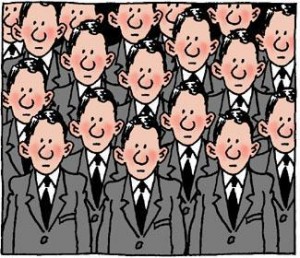Theory is arguably the most important part of research. A good theory helps researchers formulate better research questions as well as understand the results that their research projects end up producing.I’ve said this so often that expressing the idea is closer to a reflex than a thought at this point. Unfortunately, “theories” in psychology – if we can even call them theories – are frequently of poor quality, if not altogether absent from research, leading to similarly poorly formulated projects and explanations. Evolutionary theory offers an escape from this theoretically shallowness, and it’s the major reason the field appeals to me. I find myself somewhat disappointed, then, to see a new paper published in Evolutionary Psychology that appears to be, well, atheoretical.
The paper was ostensibly looking at whether or not human children sexually imprint on the facial traits of their opposite sex parent, or, more specifically (for those of you that don’t know about imprinting):
Positive sexual imprinting has been defined as a sexual preference for individuals possessing the characteristics of one’s parents… It is said to be a result of acquiring sexual preferences via exposure to the parental phenotype during a sensitive period in early childhood.
The first sentence of that definition seems to me to be unnecessary. One could have preferences for characteristics that one’s parents also happen to possess without those preferences being the result of any developmental mechanism that uses parental phenotype as its input. So I’d recommend using the second part of the definition, which seems fine, as far as describing sexual imprinting on parents goes. As the definition suggests, such a mechanism would require (1) a specified developmental window during which the imprinting takes place (i.e. the preferences would not be acquired prior to or after that time, and would be relatively resistant to change afterwards) and (2) that mechanism to be specifically focused on parental features.
So how did Marcinkowska & Rantala (2012) go about testing this hypothesis? Seventy subjects, their sexual partner, and their opposite sex parent (totaling 210 people) were each photographed from straight ahead and in profile. These subjects were also asked to report about their upbringing as a child. Next, a new group of subjects were presented with an array of pictures: on one side of the array was a picture of one of the opposite sex parents; on the other side there were four pictures, one of which was the partner of that parent’s child and three of which were controls. The new subjects were asked to rate how similar the picture of the parent was to the pictures of the people on the other side of the display.
The results showed that the group of independent raters felt that a man’s mother resembled slightly more closely his later partner than the controls did. The results also showed that the same raters did not feel that a woman’s father more closely resembled her later partner than the control did. Neither of these findings were in any way related to the self-reports that subjects had delivered about their upbringing either. If you’ve been following along so far, you might be curious as to what these results have to do with a sexual imprinting hypothesis. As far as I can tell, the answer is a resounding, “nothing”.
Discussion: Never mind…
Let’s consider what these results don’t tell us: they certainly don’t speak to the matter of preferences. As Marcinkowska & Rantala (2012) note, actual mating preferences can be constrained by other factors. Everyone in the population might wish to monopolize the matings of a series of beautiful others, but if those beautiful others have different plans, that desire will not be fulfilled. Since the initial definition of imprinting specifically referenced preferences – not actual choices – the findings would have very little relevance to the matter of imprinting no matter how the data fell out. It’s worse than that, however: this study didn’t even attempt to look for any developmental window either. The authors seemed to just assume it existed without any demonstration that it actually does.
What’s particularly peculiar about this oversight is that, in the discussion, the authors note they did not look at any adoptive families. This suggests that the authors at least realized there were ways of testing to see if this developmental window even exists, but didn’t seem to bother running the required tests. A better test – one that might suggest such a developmental window exists – would be to test preferences of adoptive or step-children towards the features of their biological and adoptive/step-parents. If the imprinting hypothesis was true, you would expect that adoptive/step-children would prefer the characteristics of their adoptive/step-parents, not their biological ones. Further, this research could be run with respect to the time at which the new parent came into the picture (and the old one left). If there is a critical developmental window, you should only expect to see this effect when the new parent entered into the equation at a certain age; not before or beyond that point.
The problems don’t even end there, however. As I mentioned previously, this paper appears atheoretical in nature, in that the authors give absolutely no reason as to why one would expect to find a sexual imprinting mechanism in the first place, why it would operate in early childhood, let alone why that mechanism would be inclined to imprint on one’s close, biological kin. What the precise fitness benefits to such a mechanism would be are entirely unclear to me, though, at the very least, I could see it carrying fitness costs in that it might heighten the probability of incest taking place. Further, if this mechanism is presumably,active in all members of our species, and each person is looking to mate with someone who resembles their opposite sex parent, it would seem that such a preference might actively disincline people from having what would be otherwise adaptive matings. Lacking any theoretical explanation for any of this, the purpose of the research seems very confusing.
On the plus side, you can still add it to your resume, and we all know how important publications are.
All that said, even if research did find that people tended to be attracted to the traits of their opposite sex parent, such a finding could, in principle, be explained by sexual selection. Offspring inherent genes from their parents that both contributed to their parent’s phenotype as well as genes that contributed to their parent’s psychological preferences. If preferences were not similarly inherited, sexual selection would be impossible and ornaments like the peacock’s tail could never have come into existence. So, presuming your parents found each other at least attractive enough to get together and mate, you could expect their offspring to resemble them both physically and psychologically to some extent. When those offspring are then making their own mate choices, you might then expect them to make a similar set of choices (all else being equal, of course).
What can be said for the study is that it’s a great example of how not to do research. Don’t just assume the effect you’re looking to study exists; demonstrate that it does. Don’t assume that it works in a particular way in the event that it actually exists either. Most importantly, don’t formulate your research project in absence of a clearly stated theory that explains why such an effect would exist and, further, why it would work the way you expect it might. You should also try and rule out alternative explanations for whatever findings you’re expecting. Without good theory, the quality of your research will likely suffer, and suffer badly.
References: Marcinkowska, U.M., & Rantala, M.J. (2012). Sexual Imprinting on Facial Traits of Opposite-Sex Parents in Humans. Evolutionary Psychology, 10, 621-630




























